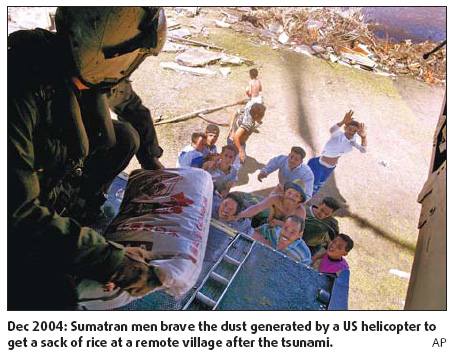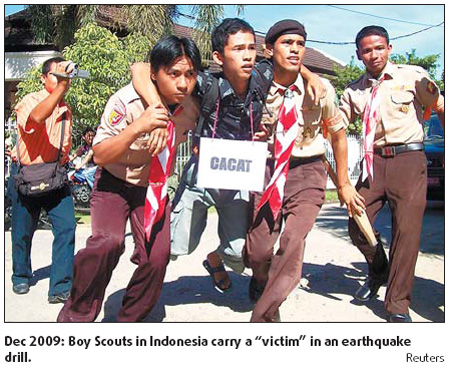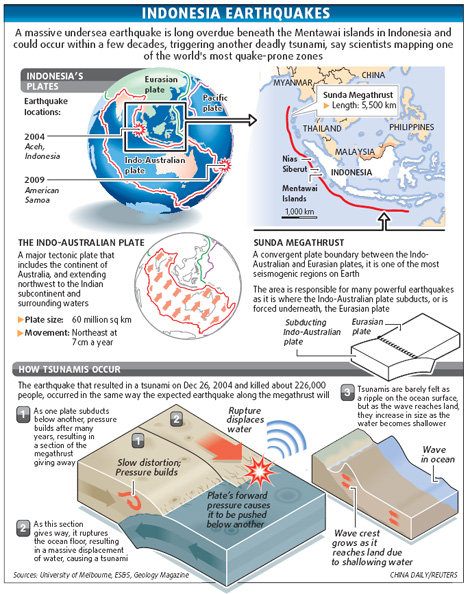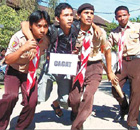Global General
5 years after Sumatra quake, experts warn of next tsunami
(China Daily)
Updated: 2009-12-25 08:23
 |
Large Medium Small |
Future disaster likely to hit area with more people
SYDNEY: A massive undersea earthquake is long overdue beneath the Mentawai islands in Indonesia and could trigger another deadly tsunami, say scientists mapping one of the world's most quake-prone zones.


Unlike the 2004 Indian Ocean tsunami, which killed around 226,000 people, this tsunami is expected to be smaller but may be very deadly as it would hit Sumatra's densely populated coast.
"The size of the tsunami may not be as big, but the problem is the size of the population is about three times as great as Aceh," said Kerry Sieh, director of the Singapore-based Earth Observatory.
A major quake measuring around 8.6 magnitude is expected beneath Siberut Island, along the Sunda megathrust, where the Indo-Australian tectonic plate butts up against the Eurasian plate - one of the world's most active fault lines.
"We say most likely in the next few decades. Thirty seconds to 30 years, somewhere in there," said Sieh, who has studied geological records showing that for the past 700 years, major quakes have occurred along the Sunda megathrust every 200 years.
There have been three major quake cycles: the late 1300s, the 1600s, and between 1797 and 1833.
"The timing between those three sequences is about two centuries," said Sieh, adding a section of the megathrust under Siberut has not ruptured for 200 years, so it is due to slip and cause a major quake.
The Sunda megathrust extends from Myanmar in the north and sweeps in a southeast arc through Sumatra, Java and towards Timor.
The northern 1,600-km section of the fault, from Myanmar to Aceh, ruptured in 2004 sending the deadly Boxing Day tsunami out into the Indian Ocean.
"The Boxing Day quake reset the (super earthquake) cycle for that segment of the fault," said Mike Sandiford at the School of Earth Sciences, University of Melbourne, Australia.
"The fault slipped up to 20 meters and that is like several hundred years of plate convergence. It should take several hundred years, if not longer, to accumulate the stress in the system to rupture on that particular strand."
The Sunda megathrust is made up of three distinct sections.
In March 2005, a powerful quake hit the second section near Nias island, causing more than 11-meter deformations beneath the island.
In 2007, an 8.4 and a 7.8 earthquake hit the southern end of the third section, the "Mentawais Patch", but not the northern part. "Now we have another 300 km that has not yet failed. It hasn't failed since 1797," Sieh said.

The 2009 Padang earthquake on Sept 30, while large, has not relieved any pressure beneath the Mentawais, as it resulted not from a rupture of the megathrust, but was on a deeper fault.
"Because that (pressure) has not been released in the Padang region, we know the stress has been building and it must eventually be released. The sort of stress which ultimately led to the big rupture at the northern end of Sumatra on Boxing Day."
One reason the Sunda megathrust generates major quakes is because it has very long fault plates that can slip as one. But because it bends as it runs south through Indonesia, scientists believe big quakes are limited to each section of the megathrust.
Singapore's Sieh paints two scenarios for the next big quake. The first is an 8.6 quake on the northern section of the Mentawais Patch.
"There is only one piece of data that tells us it last broke in 1797. If we are wrong, it may be that the last event was the 1680s. If that is the case, we could have a significantly greater uplift and significantly larger tsunami," he said.
Recent studies by Sieh suggest a second scenario, where another big quake could occur along the same section of the megathrust that caused the 2004 Boxing Day tsunami.
That quake spread a tsunami across the Indian Ocean to India and Africa. A tsunami generated from a Mentawais quake would send a wave southwest out into the empty Indian Ocean. But the wave would also hit Sumatra's densely populated coast between Padang and Bengkulu.
Reuters










